Science : Chapter 4 : Heat
TEXTBOOK EXERCISES
I. Choose the best answer.
1. Heat is a form of ________.
a. electrical energy
b. gravitational energy
c. thermal energy
d. None of these
[Answer: (c) thermal energy]
2. If you apply some heat energy to a substance, which of the following can take place in it?
a. Expansion
b. Increase in temperature
c. Change of state
d. All the above.
[Answer: (d) All the above]
3. Which of the following substances will absorb more heat energy?
a. Solid
b. Liquid
c. Gas
d. All the above
[Answer: (d) All the above]
4. If you apply equal amount of heat to a solid, liquid and gas individually, which of the following will have more expansion?
a. Solid
b. Liquid
c. Gas
d. All of them
(Answer: (c) Gas]
5. The process of converting a liquid into a solid is called_________.
a. sublimation
b. condensation
c. freezing
d. deposition
[Answer: (c) freezing]
6. Conduction is the way of heat transfer which takes place in a____________.
a. solid
b. liquid
c. gas
d. All of them
[Answer: (a) solid]
II. Fill in the blanks.
1. A calorimeter is a device used to measure the heat capacity of water.
2. Specific heat capacity is defined as the amount of heat required to raise the temperature of 1kg of a substance by 1°C.
3. A thermostat is a device which maintains temperature of an object constant.
4. The process of converting a substance from gaseous state to solid state is called deposition.
5. If you apply heat energy, the temperature of a system will increase.
6. If the temperature of a liquid in a container is decreased, then the interatomic distance will decrease.
III. State True or False. If false, correct the statement.
1. The applied heat energy can be realised as an increase in the average kinetic energy of the molecules. [Answer: True]
2. The dimensions of a substance are increased if the temperature of the substance is decreased. [Answer: False]
Correct statement: The dimensions of a substance are increased if the temperature of the substance is increased.
3. The process of converting a substance from solid state to gaseous state is called condensation. [Answer: False]
Correct statement : The process of converting a substance from solid to gas is called sublimation.
4. Convection is the process by which the thermal energy flows in solids. [Answer: False]
Correct statement : Convection is the process by which the thermal energy flows in liquids and gases.
5. The amount of heat gained by a substance is equal to the product of its mass and latent heat. [Answer: True]
6. In a thermos flask, the silvered walls reflect and radiate the heat outside. [Answer: False]
Correct statement : In a thermos flask, the silvered walls reflect radiated heat back to the liquid in the bottle.
IV. Match the following.
Conduction – Liquid
Convection – Gas to liquid
Radiation – Solid to gas
Sublimation – Vaccum
Condensation – Solid
[Answer: 1 – e, 2 – a, 3 – d, 4 – c, 5 – b]
1. Conduction (e) Solid
2. Convection (a) Liquid
3. Radiation (d) Gas
4. Sublimation (c) Solid to gas
5. Condensation (b) Gas to liquid
V. Consider the statements given below and choose the correct option.
a. Both assertion and reason are true and reason is the correct explanation of assertion.
b. Both assertion and reason are true, but reason is not the correct explanation of assertion.
c. Assertion is true, but the reason is false.
d. Assertion is false, but the reason is true.
1. Assertion: Radiation is a form of heat transfer which takes place only in vacuum.
Reason: The thermal energy is transferred from one part of a substance to another part without the actual movement of the atoms or molecules.
[Answer: (b) Both assertion and reason are true, but reason is not the correct explanation of the assertion.]
2. Assertion: A system can be converted from one state to another state.
Reason: It takes place when the temperature of the system is constant.
[Answer: (a) Both assertion and reason are true and the reason is the correct explanation of the assertion.]
VI. Answer briefly.
1. What are the applications of conduction in our daily life?
Answer:
(i) We cook food in vessels made up of metals. When the vessel is heated, heat is transferred from the metal to the food.
(ii) When we iron dresses heat is transferred from the iron to the cloth.
(iii) Handles of cooking utensils are made up of plastic or wood because they are poor conductors of heat.
(iv) The temperature inside igloo (snow house) is warm because snow is a poor conductor of heat.
2. What are the effects of heat?
Answer:
(i) Expansion
(ii) Increase in temperature
(iii) Change in state
3. Name three types of heat transfer.
Answer: Three types of heat transfer are :
(i) Conduction
(ii) Convection
(iii) . Radiation
4. What is conduction?
Answer: The process of heat transfer in solids from the region of higher temperature to the region of lower temperature without the actual movement of atoms or molecules is called as conduction.
5. Write a note on convection.
Answer: The form of heat transfer from places of high temperature to places of low temperature by the actual movement of molecules is called convection. Convection takes place in liquids and gases.
6. Define specific heat capacity.
Answer: Specific heat capacity of a substance is defined as the amount of heat energy required to raise the temperature of 1 kilogram of a substance by 1°C or 1 K. It is denoted by the symbol C.
7. Define one calorie.
Answer: One calorie is the amount of heat energy required to raise the temperature of 1 gram of water through 1°C.
VII. Answer in detail.
1. With the help of a neat diagram, explain the working of a calorimeter.
Answer:
(i) A calorimeter is a device used to measure the amount of heat gained or lost by a substance.
(ii) It consists of a vessel made up of metals like copper or aluminium which are good conductors of heat and electricity.
(iii) The metallic vessel is kept in an insulating jacket to prevent heat loss to the environment.
(iv) There are two holes in it. Through one hole a thermometer is inserted to measure the temperature of the contents.
(v) A stirrer is inserted through another hole for stirring the content in the vessel.
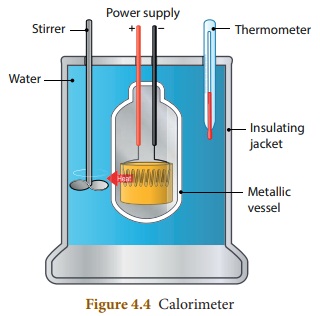
(vi) The vessel is filled with liquid which is heated by passing current through the heating element.
(vii) Using this device we can measure the heat capacity of the liquid in the container.
2. Write a note on thermostat.
Answer:
(i) A thermostat is a device which maintains the temperature of a place or an object constant.
(ii) The word thermostat is derived from two Greek words, ‘thermo’ meaning heat and ‘static’ meaning staying the same.
(iii) Thermostats are used in any device or system that gets heated or cools down – to a pre-set temperature. It turns an appliance or a circuit on or off when a particular temperature is reached.
(iv) Devices which use thermostat include building heater, central heater in a room, air conditioner, water heater, as well as kitchen equipments including oven and refrigerators.
(v) Sometimes, a thermostat functions both as the sensor and the controller of a thermal system.
3. Explain the working of thermos flask.
Answer:
(i) A thermos flask has double walls, which are evacuated.
(ii) It is silvered on the inside.
(iii) The vacuum between the two walls prevents heat being transferred from the inside to the outside bv conduction and convection.
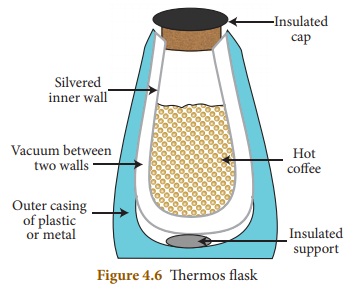
(iv) With very little air between the walls, there is almost no transfer of heat from the inner wall to the outer wall or vice versa.
(v) Conduction can only occur at the points where the two walls meet, at the top of the bottle and through an insulated support at the bottom.
(vi) The silvered walls reflect radiated heat back to the liquid in the bottle.
VIII. Higher Order Thinking Questions.
1. Why does the bottom of a lake not freeze in severe winter though the surface is all frozen?
Answer: Lakes don’t completely freeze because the ice (and eventually snow) on the surface acts to insulate the water below. To freeze water into ice, a large quantity of heat is to be withdrawn. This heat cannot be supplied all at once, so water freezes slowly and keeps the weather.
2. Which one of the following statements about thermal conductivity is correct? Give reason.
a) Steel > Wood > Water
b) Steel > Water > Wood
c) Water > Steel > Wood
d) Water > Wood > Steel
Answer: b) Steel > Water > Wood
Reason :
Thermal conductivity is defined as the heat flow per unit time.
Steel has a higher thermal conductivity than water and wood.
[Thermal conductivity of steel = 50.2 w/mk
Thermal conductivity of water = 0.6 w/mk
Thermal conductivity of wood = 0.12 w/mk]
IX. Numerical Problems.
1. An iron ball requires 1000 J of heat to raise its temperature by 20°C. Calculate the heat capacity of the ball.
Solution :
Heat capacity C’ = Q/∆T
Here, A = 1000 J
T = 20°C − 0°C = 20°C = 20K
C = 1000/20 = 50 JK−1
The heat capacity of the ball = 50 JK−1
2. The heat capacity of the vessel of mass 100 kg is 8000 J/°K. Find its specific heat capacity.
Solution :
Specific heat capacity, C = Q / [ m × ∆T]
Here, m = 100 kg
Heat capacity = Q / ∆T = 8000 J/°C = 8000 J/K
C = Q / [ m × ∆T] = 100 × 8000 J = 8,00,000 JKg-1K-1
Numerical problems
Problem 1
The temperature of a metal ball is 30° C. When an energy of 3000 J is supplied, its temperature raises by 40° C. Calculate its heat capacity.
Solution
Heat capacity, C’ = Q / ΔT
Here, Q = 3000 J
ΔT = 40°C – 30°C = 10°C or 10 K
C’ = 3000 / 10 = 300 JK-1
The heat capacity of the metal ball is 300 JK-1.
Problem 2
The energy required to raise the temperature of an iron ball by 1 K is 500 JK-1. Calculate the amount of energy required to raise its temperature by 20 K.
Solution
Heat capacity, C’ = Q / ΔT
Q=C’×ΔT
Here, C’ = 500 JK-1
ΔT=20K
Q = 500 × 20 = 10000 J.
The amount of heat energy required is 10000 J.
Problem 3
An energy of 84000 J is required to raise the temperature of 2 kg of water from 60° C to 70° C. Calculate the specific heat capacity of water.
Solution
Specific heat capacity, C = Q / m × ΔT
Here, Q = 84000 J
m = 2 kg
ΔT = 70° C – 60° C = 10° C or 10 K
C = 84000 / 2×10 = 4200 J kg-1 K-1
The Specific heat capacity of water is 4200 J kg-1 K-1.
Problem 4
The specific heat capacity of a metal is J kg-1K-1. Calculate the amount of heat energy required to raise the temperature of 500 gram of the metal from 125° C to 325° C.
Solution
Specific heat capacity, C = Q / m × ΔT
Q = C × m × ΔT
Here, C = 160 J kg K-1
m = 500 g = 0.5 kg
ΔT = 325° C – 125° C = 200° C or 200 K
= 160 × 0.5 × 200 = 16000 J.
The amount of heat energy required is 16000 J.
1. An iron ball requires 1000 J of heat to raise its temperature by 20°C. Calculate the heat capacity of the ball.
Solution :
Heat capacity C’ = Q/∆T
Here, A = 1000 J
T = 20°C − 0°C = 20°C = 20K
C = 1000/20 = 50 JK−1
The heat capacity of the ball = 50 JK−1
2. The heat capacity of the vessel of mass 100 kg is 8000 J/°K. Find its specific heat capacity.
Solution :
Specific heat capacity, C = Q / [ m × ∆T]
Here, m = 100 kg
Heat capacity = Q / ∆T = 8000 J/°C = 8000 J/K
C = Q / [ m × ∆T] = 100 × 8000 J = 8,00,000 JKg-1K-1
Student Activities
Activity 1
Take a metal ball and a metal ring of suitable diameter. Pass the metal ball through the ring. You can observe that the metal ball can easily go through it. Now heat the metal ball and then try to pass it through the ring. It will not pass through the ring. Keep the metal ball on the ring for some time. In few minutes, it will fall through the ring.
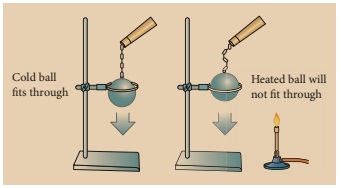
Activity 2
Take a cup of water and note its temperature. Heat the water for few minutes and note the temperature again.
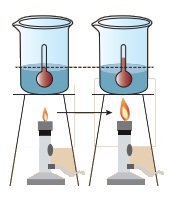
Do you find any increase in the temperature?
Answer: (i) When the water is heated, water molecules receives heat energy, increases the kinetic energy of the molecules.
What caused the temperature change?
Answer:
(i) When the molecules receive more energy, the temperature of the water increases.
(ii) Heat energy causes increase in temperature.
Activity 3
Take few ice cubes in a container and heat them for some time. What happens? The ice cubes melt and become water. Now heat the water for some time. What do you observe? The volume of water in the vessel decreases. What do you understand from this activity?
Answer:
(i) In ice cubes, the force of attraction between the water molecules is more. So they are close together.
(ii) When we heat them the force of attraction decreases and the ice cubes become water. (iii) when we heat the water, the force of attraction between the molecules decreases further.
(iv) Hence they move away from one another and become vapour.
(v) Since water vapour escape to the surrounding, water level decreases.
(vi) From this activity we understand that heat energy causes change in the state of the substances.
Activity 4
Take some hot water in a cup and put a silver spoon in it. Leave the spoon inside the water for some time. Now touch the other end of the spoon. Do you feel the heat?
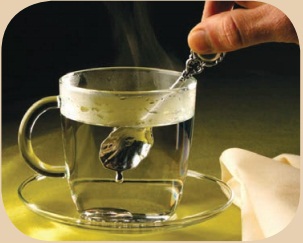
Answer:
(i) Yes, we feel hot.
(ii) It is because heat in the hot water is transferred from one end to other end of the spoon.
(iii) In solid substances such as silver spoon, atoms are arranged very closely.
(iv) So heat transfer takes place from the higher temperature region to lower temperature region.
(v) This is due to conduction.
Activity 5
Take some water in a vessel and heat it on a stove. Touch the surface of the water. It will be cold. Touch it after some time. It will be hot now. How did the heat which was supplied at the bottom reach the top?
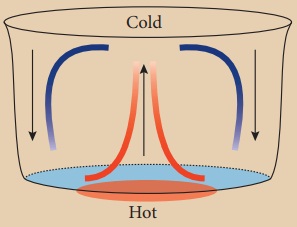
Answer:
(i) When water in the vessel is heated, water molecules at the bottom receive heat energy and move upward.
(ii) Then the molecules at the top comes down and get heated.
(iii) This kind of heat transfer is known as convection.
Activity 6
Take some amount of water and cooking oil in two separate vessels. Heat them till they reach a particular temperature (Caution: Heat the oil under the supervision of your teacher). Which one is heated first? Water will take more time to get heated. Why?
Answer:
(i) Heat transfer depends on the nature of the substance.
(ii) Water has high specific heat capacity than that of cooking oil.
(iii) A substance with high specific heat capacity absorbs a large quantity of heat.
(iv) Thus, it takes long time to heat up.
Electric wires used for long distance transmission of electricity will expand during day time and contract at night. That is why they will not be set very tightly. If they are set very tightly they will break when they cool at night.
Water is the only matter on the Earth that can be found naturally in all three states -Solid, Liquid and Gas.
All metals are good conductors of heat. The substances which does not conduct heat easily are called bad conductors or insulators.Wood, cork, cotton, wool, glass, rubber, etc are insulators.
Heat transfer by radiation is visible to our eyes. When a substance is heated to 500°C the radiation begins to become visible to the eye as a dull red glow, and it is sensed as warmth by the skin. Further heating rapidly increases the amount of radiation, and its perceived colour becomes orange, yellow and finally white.
The amount of energy in food items is measured by the unit kilo calorie.
1 kilo calorie = 4200 J (Approximately).
Water has higher heat capacity than most other substances. This accounts for the use of water as common coolant.100 g of water can take away more heat than 100 g of oil.
The world’s first ice-calorimeter was used in the year 1782 by Antoine Lavoisier and Pierre-Simon Laplace, to determine the heat generated by various chemical changes.














